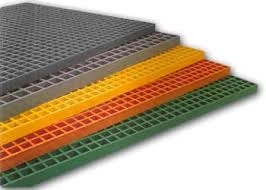loading...
- No. 9, Xingyuan South Street, Dongwaihuan Road, Zaoqiang County, Hengshui, Hebei, China
- admin@zjcomposites.com
- +86 15097380338
- Welcome to visit our website!
frp guardrail
Understanding FRP Guardrails Enhancements in Safety and Efficiency
In recent years, the use of Fiber Reinforced Plastic (FRP) in guardrail systems has gained significant attention due to its impressive properties and benefits. FRP guardrails are increasingly being adopted in various infrastructure projects, thanks to their lightweight nature, corrosion resistance, and superior strength-to-weight ratio. This article explores the advantages and applications of FRP guardrails, highlighting their role in enhancing safety and efficiency in construction and transportation sectors.
Understanding FRP Guardrails Enhancements in Safety and Efficiency
Corrosion resistance is another crucial benefit of FRP guardrails. Unlike metal guardrails that are prone to rust and degradation due to environmental elements, FRP materials are inherently resistant to corrosion. This durability ensures that FRP guardrails maintain their structural integrity over time, reducing the need for frequent maintenance or replacements. In regions with high humidity, salt exposure, or chemical pollutants, such as coastal areas or industrial zones, the longevity of FRP guardrails can significantly lower lifecycle costs for infrastructure projects.
frp guardrail

The strength-to-weight ratio of FRP guardrails is also noteworthy. These materials provide adequate strength to withstand impact forces while remaining lightweight. This characteristic is particularly important in high-traffic areas where guardrails must be capable of absorbing the energy of vehicle collisions. The robust design of FRP guardrails ensures that they provide effective protection without adding excessive weight, making them suitable for various applications, including highways, bridges, and pedestrian walkways.
Moreover, FRP guardrails can be manufactured in a variety of designs and colors, offering aesthetic versatility. This customization allows infrastructures to blend seamlessly with their surroundings while meeting safety standards. Engineers and architects appreciate the flexibility of FRP materials, as they can innovate and create visually appealing yet functional safety barriers that comply with regulatory requirements.
Another noteworthy aspect of FRP guardrails is their environmental impact. With a growing focus on sustainability, many construction projects now prioritize eco-friendly materials. FRP can be produced using recycled materials and has a longer lifespan compared to traditional materials, reducing waste in landfills. Additionally, the manufacturing process for FRP typically results in lower energy consumption, making it a more sustainable choice in the construction industry.
In conclusion, the integration of FRP guardrails into infrastructure projects offers numerous benefits that enhance safety, efficiency, and sustainability. As the demand for innovative materials continues to rise, FRP guardrails stand out as a forward-thinking solution that meets the evolving needs of modern construction and transportation. By prioritizing factors such as lightweight design, corrosion resistance, and aesthetic versatility, FRP guardrails undoubtedly contribute to safer and more efficient environments for all.
-
GRP Structures: The Future of Lightweight, High-Performance EngineeringNewsJun.20,2025
-
FRP Water Tank: High-Performance Storage for Corrosive and Clean Water SystemsNewsJun.20,2025
-
FRP Square Tube: The New Industry Standard for Chemical and Structural ApplicationsNewsJun.20,2025
-
FRP Pultruded Profiles: The Ultimate Choice for Lightweight Structural StrengthNewsJun.20,2025
-
FRP Handrails: The Safer, Smarter, and Stronger Choice for Modern InfrastructureNewsJun.20,2025
-
FRP Grating: The Smart Solution for Durable, Lightweight Industrial FlooringNewsJun.20,2025
-
Why Choose a Galvanized Water Tank for Your Storage NeedsNewsMay.21,2025
